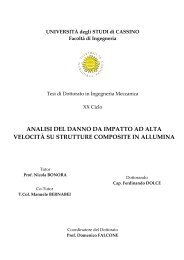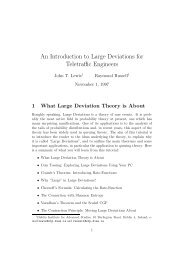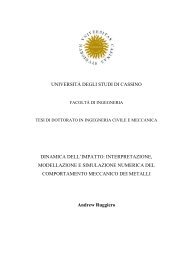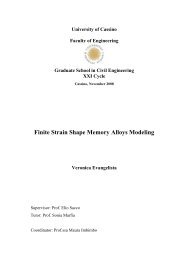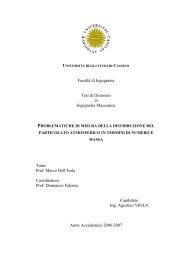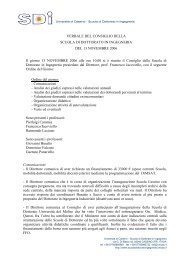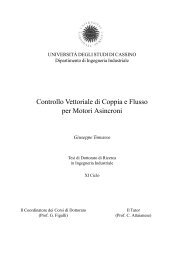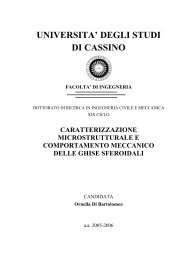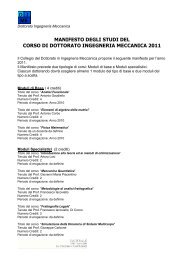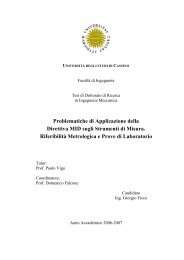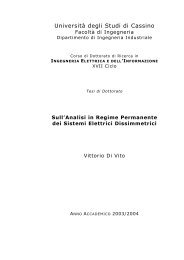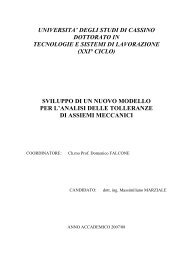Metodi e strumenti di misura per l'esecuzione di test non distruttivi ...
Metodi e strumenti di misura per l'esecuzione di test non distruttivi ...
Metodi e strumenti di misura per l'esecuzione di test non distruttivi ...
You also want an ePaper? Increase the reach of your titles
YUMPU automatically turns print PDFs into web optimized ePapers that Google loves.
Capitolo 4 Sviluppo ed ottimizzazione del sistema basato sulla Tomografia Induttiva<br />
migliore <strong>per</strong> npk < 8 (ve<strong>di</strong> figure 4.2 d), e) e/o 4.3 d), e)). Questo ha portato a scegliere un<br />
valore npk=8.<br />
a) b)<br />
I1 I2 I3<br />
[%]<br />
npk npk npk<br />
I4 [Ω] I5 [%]<br />
d)<br />
npk npk<br />
frequenza frequenza<br />
Fig. 4.2 Capacità <strong>di</strong> estrazione <strong>di</strong> P (2) nel range <strong>di</strong> frequenze 100÷1500Hz. Evoluzione degli in<strong>di</strong>ci I1 (a),<br />
I2 (b), I3 (c), I4 (d), I5 (e).<br />
Si può inoltre osservare che <strong>per</strong> contenere l’errore <strong>per</strong>centuale nell’estrazione <strong>di</strong> P (2) (in<strong>di</strong>ce<br />
I3) viene fortemente richiesto il contenuto informativo dovuto alla presenza delle matrici<br />
ottenute a basse frequenze (inferiori a 300 Hz), anche <strong>per</strong> elevati valori <strong>di</strong> npk. Infatti, nel<br />
caso <strong>di</strong> range <strong>di</strong> frequenza <strong>di</strong> 100÷1500Hz, <strong>per</strong> npk>6 l’in<strong>di</strong>ce I3 scende sotto il 5% (ve<strong>di</strong> fig.<br />
4.2c), mentre nel caso <strong>di</strong> range <strong>di</strong> frequenza <strong>di</strong> 500÷1500Hz, anche <strong>per</strong> npk>6 l’in<strong>di</strong>ce I3 <strong>non</strong><br />
scende mai al <strong>di</strong> sotto del 20% (ve<strong>di</strong> fig. 4.3c). Questo risultato conferma quanto già ottenuto<br />
nel § 4.2.1.1; qui ne viene messa in evidenza la causa ma anche l’impossibilità <strong>di</strong> risolvere<br />
questo problema me<strong>di</strong>ante una scelta opportuna del parametro nkp. Tutto ciò, unito ai<br />
summenzionati problemi <strong>di</strong> <strong>misura</strong> derivanti dall’utilizzo <strong>di</strong> basse frequenze, suggerisce la<br />
necessità sia <strong>di</strong> migliorare l’estrazione <strong>di</strong> P (2) che <strong>di</strong> incrementare il livello dei segnali.<br />
c)<br />
e)<br />
157



